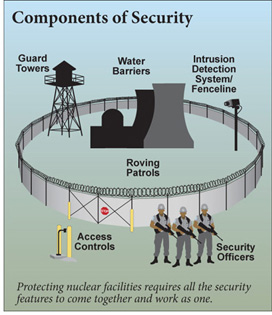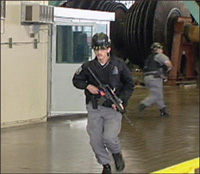|
|
Home > Electronic Reading Room > Document Collections > Fact Sheets > Defending Against Adversaries

|
 Defending Against Adversaries Defending Against Adversaries
Commercial nuclear power plants are heavily fortified with well-trained and armed guards. They also have layered physical security measures, such as access controls, water barriers, intrusion detection and strategically placed guard towers. Together, these make up the plants’ response to the Design Basis Threat – usually called the DBT. The DBT is developed from real-world intelligence information and describes the adversary force – coming from both ground and water – the plants must defend against. DBT specifics are not public in order to protect sensitive information that could aid terrorists. The NRC regularly reviews the DBT and adds new requirements when necessary.
-
Category I Fuel-Cycle Facilities
There are two NRC-licensed Category I Fuel-Cycle Facilities in the U.S. that make reactor fuel for nuclear plants. Since these plants handle nuclear material that could be targeted by adversaries, they also must defend against a DBT similar to that for nuclear power plants.
|

|
|
Force-on-Force Exercises
- The NRC routinely tests the security at nuclear facilities with realistic exercises using a well-trained mock adversary force. These force-on-force exercises are designed to test a security force’s ability to defend against the DBT. The NRC oversees every aspect of these exercises and evaluates them using rigorous standards. These exercises typically span several days. During the attack, the mock adversary force tries to reach and damage key safety systems. Any significant security problems are promptly identified, reviewed, and fixed prior to NRC’s inspection team leaving the facility. The NRC tests every plant with a force-on-force exercise a minimum of every three years. The plants also must conduct their own yearly exercises.
|
|
|
